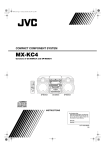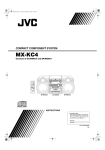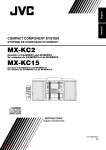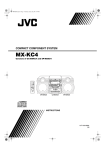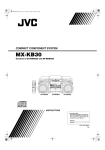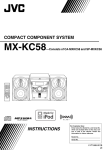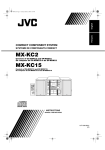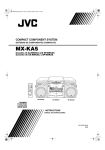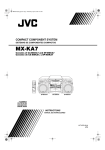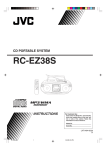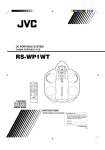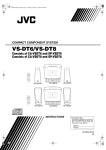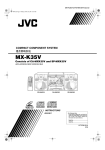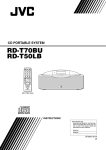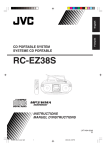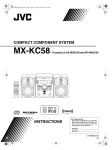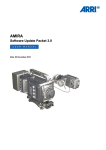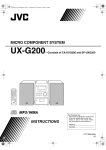Download JVC MX-KC50 User's Manual
Transcript
COMPACT COMPONENT SYSTEM
MX-KC50
Consists of CA-MXKC50 and SP-MXKC50
SP-MXKC50
CA-MXKC50
SP-MXKC50
INSTRUCTIONS
For Customer Use:
Enter below the Model No. and Serial No.
which are located either on the rear, bottom
or side of the cabinet. Retain this information for future reference.
Model No.
Serial No.
LVT1728-001A
[J]
Warnings, Cautions and Others /
Mises en garde, précautions et indications diverses
(For U.S.A)
WARNING: TO REDUCE THE RISK OF FIRE
OR ELECTRIC SHOCK, DO NOT EXPOSE
THIS APPLIANCE TO RAIN OR MOISTURE.
CAUTION
Changes or modifications not approved by JVC could
void the user’s authority to operate the equipment.
Note to CATV system installer:
This reminder is provided to call the CATV system
installer’s attention to section 820-40 of the NEC which
provides guidelines for proper grounding and, in particular,
specifies that the cable ground shall be connected to the
grounding system of the building, as close to the point of
cable entry as practical.
This equipment has been tested and found to comply
with the limits for a Class B digital device, pursuant to
Part 15 of the FCC Rules. These limits are designed
to provide reasonable protection against harmful interference in a residential installation. This equipment
generates, uses, and can radiate radio frequency
energy and, if not installed and used in accordance
with the instructions, may cause harmful interference
to radio communications. However, there is no guarantee that interference will not occur in a particular
installation. If this equipment does cause harmful
interference to radio or television reception, which can
be determined by turning the equipment off and on,
the user is encouraged to try to correct the interference by one or more of the following measures:
– Reorient or relocate the receiving antenna.
– Increase the separation between the equipment
and receiver.
– Connect the equipment into an outlet on a circuit
different from that to which the receiver is connected.
– Consult the dealer or an experienced radio/TV
technician for help.
For Canada/pour le Canada
THIS DIGITAL APPARATUS DOES NOT EXCEED THE CLASS B LIMITS FOR RADIO NOISE EMISSIONS FROM DIGITAL
APPARATUS AS SET OUT IN THE INTERFERENCE-CAUSING EQUIPMENT STANDARD ENTITLED “DIGITAL
APPARATUS,” ICES-003 OF THE DEPARTMENT OF COMMUNICATIONS.
CET APPAREIL NUMERIQUE RESPECTE LES LIMITES DE BRUITS RADIOELECTRIQUES APPLICABLES AUX
APPAREILS NUMERIQUES DE CLASSE B PRESCRITES DANS LA NORME SUR LE MATERIEL BROUILLEUR:
“APPAREILS NUMERIQUES”, NMB-003 EDICTEE PAR LE MINISTRE DES COMMUNICATIONS.
CAUTION –– % STANDBY/ON button !
Disconnect the mains plug to shut the power off completely
(all lamps and indications go off). When installing the
product, ensure that the plug is easily accessible. The %
STANDBY/ON button in any position does not disconnect
the mains line.
• When the unit is on standby, the STANDBY lamp lights red.
• When the unit is turned on, the STANDBY lamp goes off.
The power can be remote controlled.
G-1
ATTENTION –– Touche % STANDBY/ON
Déconnectez la fiche de secteur pour mettre l’appareil
complètement hors tension (tous les témoins et toutes les
indications s’éteignent). Lors de l’installation de l’appareil,
assurez-vous que la fiche soit facilement accessible. La
touche % STANDBY/ON dans n’importe quelle position ne
déconnec-te pas l’appareil du secteur.
• Quand l’appareil est en mode d’attente, le témoin
STANDBY est al-lumé en rouge.
• Quand l’appareil est sous tension, le témoin STANDBY
s’éteint.
L’alimentation ne peut pas être commandée à distance.
IMPORTANT FOR LASER PRODUCTS / IMPORTANT POUR PRODUITS LASER
1. CLASS 1 LASER PRODUCT
2. CAUTION: Do not open the top cover or the cabinet. There are no user serviceable parts inside the unit; leave all servicing to
qualified service personnel.
3. CAUTION: (For U.S.A.) Visible and/or invisible class II laser radiation when open. Do not stare into beam. (For Canada) Visible and/or invisible class 1M laser radiation when open. Do not view directly with optical instruments.
4. REPRODUCTION OF LABEL: CAUTION LABEL, PLACED INSIDE THE UNIT.
1. PRODUIT LASER CLASSE 1
2. ATTENTION: N'ouvrez pas le couvercle supérieur ni le boîtier. Il n’y a aucune pièce réparable par l’utilisateur à
l’intérieur de l’appareil; confiez toute réparation à un personnel qualifié.
3. ATTENTION: (Pour les Etats-Unis) Radiation laser de classe II visibles et/ou invisible si l’appareil est ouvert. Ne regardez pas le rayon. (Pour le Canada) Rayonnement laser visible et/ ou invisible de classe 1M une fois ouvert. Ne pas
regarder directement avec des instruments optiques.
4. REPRODUCTION DE L’ÉTIQUETTE: ÉTIQUETTE DE PRÉCAUTION PLACÉE À L’INTERIEUR DE L’APPAREIL.
CAUTION
ATTENTION
To reduce the risk of electrical shocks, fire, etc.:
1. Do not remove screws, covers or cabinet.
2. Do not expose this appliance to rain or moisture.
Afin d’èviter tout risque d’électrocution, d’lncendie. etc.:
1. Ne pas enlever les vis ni les panneaux et ne pas ouvrir le coffret de
l’appareil.
2. Ne pas exposer l’appareil à la pluie ni à l’humidité.
CAUTION
ATTENTION
1. Do not block the ventilation openings or holes.
(If the ventilation openings or holes are blocked by a
newspaper or cloth, etc., the heat may not be able to
get out.)
2. Do not place any naked flame sources, such as lighted
candles, on the apparatus.
3. When discarding batteries, environmental problems
must be considered and local rules or laws governing
the disposal of these batteries must be followed strictly.
4. Do not expose this apparatus to rain, moisture, dripping
or splashing and that no objects filled with liquids, such
as vases, shall be placed on the apparatus.
1. Ne bloquez pas les orifices ou les trous de ventilation.
(Si les orifices ou les trous de ventilation sont bloqués
par un journal un tissu, etc., la chaleur pent ne pas être
évacuée correctement de l’appareil.)
2. Ne placez aucune source de flamme nue, telle qu’une
bougie, sur l’appareil.
3. Lors de la mise au rebut des piles, veuillez prendre en considération les problèmes de l’environnement et suivre strictement les règles et, les lois locales sur la mise au rebut des piles.
4. N’exposez pas cet appareil à la pluie, à l’humidité, à un
égouttement ou à des éclaboussures et ne placez pas des
objets remplis de liquide, tels qu’un vase, sur l’appareil.
CAUTION:
ATTENTION:
Excessive sound pressure from earphones or headphones can
cause hearing loss.
Une pression acoustique excessive des écouteurs ou du
casque d’écoute peut entraîner une perte auditive.
Caution: Proper Ventilation
Attention: Aération correcte
To avoid risk of electric shock and fire, and to prevent damage, locate the apparatus
as follows:
1. Front:
No obstructions and open spacing.
2. Sides/ Top/ Back:
No obstructions should be placed in the areas shown by the dimensions below.
3. Bottom:
Place on the level surface. Maintain an adequate air path for ventilation by
placing on a stand with a height of 10cm (315/16 in.) or more.
Pour prévenir tout risque de décharge électrique ou d’incendie et éviter toute
détérioration, installez l’appareil de la manière suivante:
1. Avant:
Bien dégagé de tout objet.
2. Côtés/dessus/dessous:
Assurez-vous que rien ne bloque les espaces indiqués sur le schéma ci-dessous.
3. Dessous:
Posez l’appareil sur une surface plane et horizontale. Veillez à ce que sa
ventilation correcte puisse se faire en le plaçant sur un support d’au moins
dix centimètres de hauteur.
Front view
Face
15cm
(5 15 /16 in)
Side view
Côt
15cm
(5 15 /16 in)
1cm
( 7 /16 in)
1cm
( 7 /16 in)
15cm
(5 15 /16 in)
15cm
(5 15 /16 in)
15cm
(5 15 /16 in)
10cm
(3 15 /16 in)
About the cooling fan
Cooling fan is built into the main unit. The internal cooling fan automatically rotates for emitting generated heat. To ensure sufficient cooling, leave a
space of more than 1 cm between the main unit and the speakers or other objects.
À propos du ventilateur de refroidissement
Un ventilateur de refroidissement est incorporé dans l’unité principale. Ce ventilateur de refroidissement interne tourne automatiquement pour libérer la
chaleur générée. Afin de garantir un refroidissement suffisant, laissez un espace de plus d’1 cm entre l’unité principale et les enceintes ou d’autres objets.
G-2
Introduction
Thank you for purchasing the JVC Compact Component System.
We hope it will be a valued addition to your home, giving you years of enjoyment.
Be sure to read this instruction manual carefully before operating your new stereo system.
In it you will find all the information you need to set up and use the system.
If you have a query that is not answered by the manual, please contact your dealer.
Features
Here are some of the things that make your System both powerful and simple to use.
❏ The controls and operations have been redesigned to make them very easy to use, freeing you to just enjoy the
music.
• With JVC’s COMPU PLAY you can turn on the System and automatically start the Radio, Cassette Deck, or
CD Player with a single touch.
❏ The great SEA (Sound Effect Amplifier) effects Rock, Pop and Classics are provided.
❏ The Sound Turbo function provides emphasized rich sound.
❏ A 45-station preset capability (30 FM and 15 AM) in addition to auto-seek and manual tuning.
❏ CD changer function can operate 3 discs.
• Discs can be changed during play using the Carrousel tray (rotational tray).
❏ Two Decks enabling tape dubbing.
❏ Timer functions; Daily Timer, REC (Recording) Timer, and Sleep Timer.
❏ You can connect various external units, such as an MD recorder.
❏ The CD Player can play back a CD-R and CD-RW.
How This Manual Is Organized
• Basic information that is the same for many different functions - e.g. setting the volume - is given in the section “Basic Operations”,
and not repeated under each function.
• The names of buttons/controls and display messages are written in all capital letters: e.g. FM/AM, “NO DISC”.
• If the button names on the Unit and the Remote Control are the same, the description on where the button is used will be omitted.
• System functions are written with an initial capital letter only: e.g. Normal Play.
Use the table of contents to look up specific information you require.
We have enjoyed making this manual for you, and hope it serves you in enjoying the many features built into your System.
IMPORTANT CAUTIONS
1
Installation of the System
• Select a place which is level, dry and neither too hot nor too cold. (Between 5°C and 35°C or 41°F and 95°F.)
• Leave sufficient distance between the System and a TV.
• Do not use the System in a place subject to vibrations.
2
Power cord
• Do not handle the power cord with wet hands!
• Some power is always consumed as long as the power cord is connected to the wall outlet.
• When unplugging the System from the wall outlet, always pull the plug, not the power cord.
3
Malfunctions, etc.
• There are no user serviceable parts inside. In case of system failure, unplug the power cord and consult your dealer.
• Do not insert any metallic object into the System.
1
Table of Contents
Introduction ...................................................................................................................1
Features.................................................................................................................................................... 1
How This Manual Is Organized............................................................................................................... 1
IMPORTANT CAUTIONS..................................................................................................................... 1
Table of Contents ..........................................................................................................2
Getting Started ..............................................................................................................3
Accessories .............................................................................................................................................. 3
How To Put Batteries In the Remote Control.......................................................................................... 3
Using the Remote Control ....................................................................................................................... 3
Connecting the FM Antenna.................................................................................................................... 4
Connecting the AM Antenna................................................................................................................... 5
Connecting the Speakers ......................................................................................................................... 5
Connecting External Equipment.............................................................................................................. 6
Connecting to the Wall Outlet ................................................................................................................. 6
DEMO Mode ........................................................................................................................................... 6
COMPU Play........................................................................................................................................... 6
Basic Operations...........................................................................................................7
Turning the Power On and Off ................................................................................................................ 7
ECO Mode (ECO) ................................................................................................................................... 7
Adjusting the Volume.............................................................................................................................. 8
Fade-out Muting (FADE MUTING) ....................................................................................................... 8
Emphasizing the sound (SOUND TURBO)............................................................................................ 8
Selecting the Sound Mode (SOUND MODE)......................................................................................... 8
Entering the Number with the Remote Control (Numeric Keys)............................................................ 8
Changing the Display .............................................................................................................................. 8
Using the Tuner .............................................................................................................9
Tuning In a Station .................................................................................................................................. 9
Presetting Stations ................................................................................................................................. 10
To Change the FM Reception Mode ..................................................................................................... 10
Using the CD Player ....................................................................................................11
To Load CDs ......................................................................................................................................... 12
To Unload CDs...................................................................................................................................... 12
Changing the MP3/WMA Playback Mode............................................................................................ 12
Basics of Using the CD Player-Normal Play......................................................................................... 13
Resume Play for Audio CD and MP3/WMA Disc................................................................................ 14
Programming the Playing Order of the Tracks...................................................................................... 14
Random Play.......................................................................................................................................... 15
Repeating Tracks ................................................................................................................................... 15
Tray Lock Function ............................................................................................................................... 15
Using the Cassette Deck (Listening to a Tape) ........................................................16
Playing a Tape ....................................................................................................................................... 16
Using the Cassette Deck (Recording) ......................................................................17
Standard Recording ............................................................................................................................... 18
CD Synchro Recording.......................................................................................................................... 18
Tape to Tape Recording (DUBBING)................................................................................................... 18
Using an External Equipment ....................................................................................19
Listening to the External Equipment ..................................................................................................... 19
Using the Timers .........................................................................................................20
Setting the Clock ................................................................................................................................... 20
Fixing the Clock .................................................................................................................................... 20
Setting the Daily Timer ......................................................................................................................... 21
Setting the REC (Recording) Timer ...................................................................................................... 22
Setting the SLEEP Timer ...................................................................................................................... 24
Timer Priority ........................................................................................................................................ 24
Care And Maintenance................................................................................................25
Troubleshooting ..........................................................................................................26
Specifications ...............................................................................................Back cover
2
Getting Started
Accessories
Make sure that you have all of the following items, which are supplied with the System.
AM Loop Antenna (1)
FM Wire Antenna (1)
Remote Control (1)
Batteries (2)
Stereo Mini Plug Cable (1)
If any of these items are missing, contact your dealer immediately.
How To Put Batteries In the Remote Control
Match the polarity (+ and –) on the batteries with the + and – markings in the battery compartment.
R6P(SUM-3)/AA(15F)
CAUTION:
• Battery shall not be exposed to excessive heat such as sunshine, fire or the like.
❏ To avoid battery leakage or explosion:
• Remove batteries when the Remote Control will not be used for a long time.
• When you need to replace the batteries, replace both batteries at the same time with new ones.
• Do not use an old battery with a new one.
• Do not use different types of batteries together.
Using the Remote Control
The Remote Control makes it easy to use many of the functions of the System from a distance of up to 7m (23 feet) away.
You need to point the Remote Control at the remote sensor on the System’s front panel.
Remote sensor
CAUTION:
• Make all connections before plugging the System into an AC power outlet.
3
Getting Started
Connecting the FM Antenna
Using the Supplied Wire Antenna
FM wire antenna
Using the Coaxial Type Connector (Not supplied)
A 75Ω antenna with coaxial type connector (IEC or DIN45 325) should be connected to the FM 75Ω COAXIAL terminal.
If reception is poor, connect the outdoor antenna.
FM outdoor antenna
(Not supplied)
Coaxial cable
• Before attaching a 75 ohm coaxial lead (the kind with a round wire going to an outdoor antenna), disconnect the supplied
FM Wire Antenna.
4
Getting Started
Connecting the AM Antenna
Rear Panel of the Unit
AM antenna wire (not supplied)
If reception is poor, connect the outside antenna.
Turn the loop until you
have the best reception.
AM loop antenna (Supplied)
Attach the AM loop to its base by snapping the
tabs on the loop into the slot in the base.
• Even when connecting an outside AM antenna, keep the indoor AM loop connected.
CAUTION:
• To avoid noise, keep antennas away from the System, the connecting cord and the AC power cord.
Connecting the Speakers
1. Open each of the terminals to connect the speaker wire leads.
2. Connect the speaker cords to the Speaker terminals of the Unit.
Connect the gray (+) and gray with black stripe (–) cords of the right side speaker to the red (+) and black (–) terminals marked RIGHT
on the System.
Connect the gray (+) and gray with black stripe (–) cords of the left side speaker to the red (+) and black (–) terminals marked LEFT on
the System.
3. Close each of the terminals.
Right side (rear view)
Left side (rear view)
Gray
Gray with
black stripe
Gray
Gray with
black stripe
CAUTIONS:
• A TV may display irregular colors if located near the speakers. If this happens, set the speakers away
from the TV.
• Use speakers with the correct impedance only. The correct impedance is indicated on the rear panel.
5
Getting Started
Connecting External Equipment
Connect a signal cord with stereo mini plugs (not supplied) between the System’s AUX jack on the front panel and the audio output jack
or output terminals of the external portable CD, MD player, STB, etc.
You can then listen to the external source through the System.
To audio output of
external equipment.
Stereo mini plug cable (supplied)
Connecting to the Wall Outlet
Plug the AC power cord into the wall outlet.
Now, your System is at your command!
DEMO Mode
When the System is connected to the wall outlet, a DEMO mode displaying some of the system’s features automatically starts.
To turn the DEMO display off, press any of the operation buttons. The DEMO display automatically stops.
To turn the DEMO display on, press the DEMO button on the Unit for more than 2 seconds.
(For 2 seconds)
• While the System is turned on, the DEMO display will automatically starts if no operation is made for 2 minutes. To cancel
this auto DEMO display function, press the CANCEL button on the Unit during DEMO display.
COMPU Play
JVC’s COMPU PLAY feature lets you control the most frequently used System functions with a single touch.
With One Touch Operation you can play a CD, a tape, turn on the radio, or listen to an external equipment with a single press of the play
button for that function. One Touch Operation turns the power on for you, then starts the function you have specified. If the System is not
ready (no CD or tape in place), the System still powers on so you can insert a CD or tape.
How One Touch Operation works in each case is explained in the section dealing with that function.
The COMPU PLAY buttons are:
On the Unit
CD 6 button
FM/AM button
TAPE A 3, TAPE B 3 buttons
AUX button
CD1, CD2 and CD 3 buttons
CD Open/Close 0 button
On the Remote Control
CD 6 button
FM/AM button
TAPE A, TAPE B buttons
AUX button
CD1, CD2 and CD 3 buttons
6
Basic Operations
)
STANDBY/ON
Numeric
keys
Display
STANDBY indicator
(STANDBY/ON)
ECO
SOUND TURBO
PHONES
DISPLAY
SOUND
TURBO
VOLUME +, –
SOUND
MODE
FADE MUTING
SOUND MODE
VOLUME
Various information
Sound Turbo indicator
Sound Mode indicator
Level bar
Status bar (Indicates various statuses.)
* When the System is in use, the display shows other items as well.
For simplicity, we show here only the items described in this section.
Turning the Power On and Off
Turning the System On
1
Press the
STANDBY/ON button.
or
The display comes on and “POWER ON” is displayed once.
The STANDBY indicator goes out.
The System comes on ready to continue in the mode it was in
when the power was last turned off.
Turning the System Off
1
Press the
STANDBY/ON button again.
or
“GOOD BYE” is displayed and the display goes out, except
for the clock display. The STANDBY indicator lights up. (The
display is dimmed.)
• Some power is always consumed even though power is
turned off (called Standby mode).
• To switch off the System completely, unplug the AC power
cord from the wall outlet. When you unplug the AC power
cord, the clock will be reset to AM 12:00 immediately.
7
ECO Mode (ECO)
The System has three energy modes; power on, power off (Standby) and ECO. In ECO mode, the display goes off and the least
power is consumed.
To enter ECO mode, press the ECO button on the Unit in Standby mode (while the STANDBY indicator lights up). “ECO
MODE” appears on the display, then the display goes off. The
STANDBY indicator remains lit.
To cancel ECO mode and turn on the power, press the
STANDBY/ON button on the Unit.
To cancel ECO mode and enter Standby mode, press the
ECO button again.
Basic Operations
Adjusting the Volume
Turn the VOLUME control on the Unit clockwise to increase the
volume or turn it counterclockwise to decrease the volume.
Press the VOLUME + button on the Remote Control to increase
the volume or press the VOLUME – button on the Remote Control
to decrease the volume.
You can set the volume level to MIN, 1-30, or MAX.
Selecting the Sound
(SOUND MODE)
Mode
You can select one of 3 SEA (Sound Effect Amplifier) modes.
You can use this effect only for playback.
To get the effect, press the SOUND MODE button until Sound
Mode you want appears on the display.
The SOUND MODE indicator lights up in the display.
Each time you press the button, the SOUND MODE changes as
follows:
ROCK = POP = CLASSIC = FLAT = (back to the beginning)
• When you turn the power off at a volume level of over 19,
the volume level is automatically set to 19 when the power
is turned back on.
To cancel the effect, press the SOUND MODE button until
“FLAT” appears on the display.
The “SOUND MODE” indicator goes off.
ROCK
CAUTIONS:
• DO NOT turn on the System and/or start playing
any source without first setting the VOLUME
control to minimum, as a sudden blast of sound
could damage your hearing, speakers and/or
headphones.
POP
CLASSIC
FLAT
Boosts low and high frequencies. Good for
acoustic music.
Good for vocal music.
Set for wide and dynamic sound stereo
systems.
No sound effect applies.
For private listening
Entering the Number with the
Remote Control (Numeric Keys)
Connect a pair of headphones to the PHONES jack. No sound
comes out of the speakers.
Be sure to turn down the volume before connecting or putting on
headphones.
You will use the number keys on the Remote Control to enter numbers for presetting stations, recalling the preset stations, or programming the playing tracks on CDs.
How to enter the number with the number keys is explained here.
Fade-out Muting (FADE MUTING)
You can mute the output with one touch operation.
To muting the output, press the FADE MUTING button on the
Remote Control. The output is faded out.
To release muting, press the FADE MUTING button once
again. The output is faded in to the previous level.
• After Fade-out Muting, turning the VOLUME control on the
unit or pressing the VOLUME button on the Remote Control
will increase the volume from the previous level.
Emphasizing the sound
(SOUND TURBO)
Examples:
• To enter number 5, press 5.
• To enter number 15, press 10 = 1 = 5.
• To enter number 20, press 10 = 2 = 0.
(For MP3/WMA disc only)
• To enter number 125, press 10 (2 times) = 1 = 2 = 5.
Changing the Display
On the Remote Control ONLY
Each time you press the DISPLAY button, the display changes as
shown below:
Currently selected source ï Current time
High and low frequencies are highly boosted.
To get the effect, press the SOUND TURBO button.
The SOUND TURBO indicator lights up and “S-TURBO” appears
on the display.
To cancel the effect, press the button again.
The SOUND TURBO indicator goes out and “OFF” appears on
the display.
8
Using the Tuner
Numeric
keys
SET
FM/AM
FM/AM
FM MODE
1
Á
1
¢
Á
4
Band display, Frequency display, Preset channel
FM mode indicators
* When the System is in use, the display shows other items as well.
For simplicity, we show here only the items described in this section.
You can listen to FM and AM stations. Stations can be tuned in
manually, automatically, or from preset memory storage.
❏ Before listening to the radio:
• Make sure that both the FM and AM antennas are correctly
connected. (See pages 4 and 5.)
One Touch Radio
Just press the FM/AM button to turn on the System and start playing the station you were last tuned to.
❏ You can switch from any other sound source to the radio by
pressing the FM/AM button.
Tuning In a Station
• Manual Tuning
Briefly press the 22 or Á button to move from frequency
to frequency until you find the station you want.
OR
• Auto Tuning
If you hold down the 22 or Á button for 1 second or
more and then release it, the frequency changes down, or up,
automatically until a station is found.
OR
• Preset Tuning (Possible only after presetting stations)
Preset tuning using the Unit:
Select the preset number you want, using the 4 or ¢
button.
Example:
1
Press the FM/AM button.
The Band and Frequency you were last tuned to appear on the
display.
Each time you press the button, the band alternates between
FM and AM.
Press the ¢ button until the preset number “P-12” appears
on the display. Then, the display will show the preset
number’s band and frequency.
or
2
9
Select a station using one of the following
methods.
Preset tuning using the Remote Control:
Enter the preset number you want to recall using the numeric keys. See “Entering the Number with the Remote Control” on page 8.
Using the Tuner
CAUTION:
• In AM broadcast, reception sensitivity will be changed by
turning the AM loop antenna. Turn the AM loop antenna
for best reception.
• Even if the System is unplugged or if the power
failure occurs, the preset stations will be stored
for a few days. However, in case the preset stations are erased, you will need to preset the stations again.
Presetting Stations
You can preset up to 30 FM stations and up to 15 AM stations.
• Preset numbers may have been set to factory test frequencies prior to shipment. This is not a malfunction. You
can preset the stations you want into memory by following
one of the presetting methods below.
• During presetting stations, if no button operation is made
for 5 seconds, the display returns to the band/frequency
display. In this case, repeat steps from the beginning.
TUNING
PRESET
or
or
FM=30, AM=15
When changing the Band
On the Unit
1
2
3
Select a band by pressing the FM/AM button.
Press the 22 or Á button to tune in a station.
To Change the FM Reception
Mode
When you are tuned in to an FM stereo broadcast, the “ST (Stereo)” indicator lights up and you can hear stereo effects.
If an FM stereo broadcast is hard to receive or noisy, you can select
Monaural mode. Reception improves, but you lose stereo effect.
Press the FM MODE button on the Remote Control so
that the “MONO” indicator lights up on the display.
ST
MONO
To restore the stereo effect, press the FM MODE button on
the Remote Control so that the “MONO” indicator goes off.
Using the CD
Player
Using the CD
Player
Press the SET button.
“SET” will blink for 5 seconds.
4
While “SET” is blinking, press the 4 or ¢
button to select the preset number.
¢:
4:
5
Increases the preset number by 1.
Decreases the preset number by 1.
Press the SET button.
“STORED” appears and, after 2 seconds, the display returns to
the band/frequency display.
6
Repeat above steps 2 to 5 for each station
you want to store in memory with a preset
number.
To change the preset stations, repeat the same steps as
above.
• In step 4, you can select the preset number using the numeric keys on the Remote Control. See “Entering the
Number with the Remote Control” on page 8.
10
Using the CD Player
CD Open/
Close 0
DISC SKIP
CANCEL
CD1-CD3
Numeric
keys
4
CD1-CD3
SET/RESUME
CD 6
¢
REPEAT
PROGRAM
RANDOM
¢
1
7
Á
7
4
CD 6
REPEAT
RANDOM
PROGRAM
MP3/WMA
MODE
Track number, Playing time,
Program number, etc.
WMA
indicator
MP3 indicator
Program indicator
Disc indicators
Random Repeat
indicator indicator
* When the System is in use, the display shows other items as well.
For simplicity, we show here only the items described in this section.
This unit has been designed to playback the following CDs:
• Audio CD
• CD-R (CD-Recordable)
• CD-RW (CD-ReWritable)
• MP3/WMA disc (MP3/WMA files recorded on a CD-R or CDRW)*
Recordable
ReWritable
Only CDs bearing these marks can
be used with this System. However,
continued use of irregular shape
CDs (heart-shape, octagonal, etc.)
can damage the System.
When playing a CD-R or CD-RW
• User-edited CD-Rs (CD-Recordable) and CD-RWs (CD-ReWritable) can be played back when they are already “finalized.”
• Before playing back CD-Rs or CD-RWs, read their instructions
or cautions carefully.
• Some CD-Rs or CD-RWs may not be played back on this unit
because of their disc characteristics, damage or stain on them,
or if the player’s lens is dirty.
• CD-RWs may require a longer readout time since the reflectance of CD-RWs is lower than for regular CDs.
• Microsoft and Windows Media are either registered trademarks
or trademarks of Microsoft Corporation in the United States
and/or other countries.
*For MP3/WMA discs
• This unit manages files and folders on MP3/WMA discs as
“tracks” and “albums.”
• Playback order of the MP3/WMA files (tracks) recorded on a
disc are determined by the writing (or encoding) application;
therefore, playback order may be different from the one you
have intended while recording the files and the folders.
• This unit shows the file (track) names and ID3v2 tags (only
“Title”, “Artist” and “Album”) on the display after starts play;
however, there is a limitation on available characters and some
file names and ID3 tags are not shown correctly.
More about MP3/WMA discs
• MP3/WMA discs (either CD-R or CD-RW) require a longer
readout time. (It varies due to the complexity of the recording configuration.)
• When making an MP3/WMA disc, select ISO 9660 Level 1
or Level 2 as the disc format.
• This unit does not support multisession recording.
• This unit can play MP3/WMA files only with the following
file extensions— “.mp3” and “.wma”.
• Non-MP3/WMA files are ignored. If non-MP3/WMA files
are recorded together with MP3/WMA files, this unit will
take a longer time to scan the disc. It may also cause the
unit to malfunction.
• Some MP3/WMA discs may not be played back because
of their disc characteristics or recorded conditions.
Caution for DualDisc playback
The Non-DVD side of a “DualDisc” does not comply with the
“Compact Disc Digital Audio” standard. Therefore, the use of
Non-DVD side of a DualDisc on this product may not be recommended.
11
Using the CD Player
About Disc Indicator:
Disc Rotation
indicator
Disc Number
indicator
Selected Disc
indicator
The Disc indicator consists of the following three kinds of indicators:
Disc Number indicator: Lights all the time.
Selected Disc indicator:Lights for the currently selected
disc number.
Disc Rotation indicator:Runs when the selected CD is
playing or paused. This indicator
goes out if a CD is not loaded for
the selected disc number.
One Touch Play
The power comes on, and operations are done automatically.
❏ By pressing the CD 6 button, the System will come on, and if
a CD is loaded for the disc number that was lastly selected, it
will start playing from the first track.
❏ By pressing the CD1-CD3 button, the System will come on, and
if a CD is already loaded for the selected disc number, it will
start play from the first track.
❏ When you use an 8 cm (3'') CD, place it on the inner circle of the
tray.
❏ You can load CDs while listening to the other source or while
listening to the CD being played back.
❏ When power is turned off with the tray opened, the tray is automatically closed.
❏ If the CD cannot be read correctly (because it is scratched, for
example), “ NO DISC” appears on the display.
To Unload CDs
Take out the CD as shown below.
1
While the CD Player is stopped, press the CD
Open/Close 0 button on the Unit to open the
tray.
2
Remove the CD, then press the DISC SKIP
button on the Unit.
The tray turns for the next CD.
3
4
Repeat step 2 to remove all the CDs.
Press the CD Open/Close
Unit to close the tray.
0 button on the
❏ You can remove CDs while listening to the other source.
1
Press the CD Open/Close
Unit to open the tray.
0 button on the
Tips:
• Removing/changing the CDs during playback
While playing back a CD (e.g. CD1), you can remove or change
the other CDs (e.g. CD2 and CD3) by pressing the CD Open/Close
0 button. After removing or changing, press the same button to
close the tray.
2
Place one or two CDs, with its label side up,
onto the tray.
Changing the MP3/WMA Playback
Mode
To Load CDs
Be sure that the CD is securely seated inside the recess on the
disc tray.
With the label side up
When playing an MP3/WMA disc, you can choose the playback
mode of the MP3/WMA disc as follows:
TRACK mode:
The unit recognizes only tracks (files). You can play an MP3/
WMA disc like an Audio CD.
GROUP mode:
The unit recognizes tracks (files) and albums (folders) on an MP3/
WMA disc. You can play an MP3/WMA disc according to the way
how they are grouped.
On the Remote Control ONLY
Press MP3/WMA MODE before or during playing
an MP3/WMA disc.
GROUP indicator appears when the MP3/WMA
playback mode is the GROUP mode.
3
Press the DISC SKIP button on the Unit and
place the next CD.
When you press the button, the tray turns for the next CD.
4
Press the CD Open/Close
Unit.
The tray is closed.
0 button on the
• Each time you press the button, the MP3/WMA playback mode
changes between “GROUP” and “TRACK” alternately.
12
Using the CD Player
Basics of Using the CD PlayerNormal Play
To Play CDs
1
2
GROUP mode
Total group number
Load CDs.
Press one of the Disc button (CD1-CD3) you
want to play.
The selected disc number (e.g. “CD DISC 1”) appears on the
display.
The first track of the selected CD begins playing. When the
first CD finishes playing, the next and the third CDs are continuously played back.
When the last CD has finished playing, it will return to the first
CD and the CD Player automatically stops.
❏ You can start to play the currently selected disc by simply pressing the CD 6 button.
For Audio CD
CD is
playing
Track number Elapsed playing time
For MP3/WMA disc (The illustrations are for MP3 discs.)
TRACK mode
Track number
GROUP mode
Track number of the current group
• After the display above is shown, if the tracks include ID3
tags, the display will scroll in the order of file name, title, artist, and album, then returns to the original display.
When the Disc button (CD1-CD3) is pressed with the tray opened,
the tray is closed and the selected CD automatically begins playing.
To stop playing the CD, press the 7 button.
For Audio CD
Total track number Total playing time
For MP3/WMA disc
TRACK mode
Total track number
Total track number
To pause, press the CD 6 button. The playing time indication
blinks on the display.
To cancel pause, press the CD 6 button again. Play continues
from the point where it was paused.
Tips:
• Playing back the CD using the DISC SKIP button
You can also play the CDs using the DISC SKIP button. During
playback, each time you press the button, the next CD is automatically played back. If the next disc tray is empty, the disc tray is
automatically skipped.
To Select a Track
During playback:
Briefly press the 4 or ¢ button to select the track you want to
play, except for MP3/WMA GROUP mode.
By pressing the button, you can skip to the next track or skip back
to the previous track.
• The selected track starts playing.
• Press the ¢ button once to skip to the beginning of the next
track.
• Press the 4 button to skip to the beginning of the current
track. Press twice quickly to skip to the beginning of the previous track.
In Stop mode:
By briefly pressing the 4 or ¢ button, the CD Player operates
in the same way as during playback, except for MP3/WMA
GROUP mode.
Using the numeric keys on the Remote Control:
Using the numeric keys, you can directly select the track on the
currently selected CD.
• The selected track starts playing.
See “Entering the Number with the Remote Control” on page 8.
In MP3/WMA GROUP mode:
The selected track of the current group starts playing.
Tips:
• For MP3/WMA discs
When the selected track starts playing, information of that track
scrolls on the display, in the order of file name, title, artist, and album.
To Select a Group (For MP3/WMA GROUP mode
only)
During playback:
Briefly press the 4 or ¢ button to select the group you want
to play.
• The first track of the selected group starts playing.
In Stop mode:
Briefly press the 4 or ¢ button to select the group you want
to play. The group number, the group name and the file name scroll
on the display.
Search Play
Holding down the following buttons, during playback, will fast
forward/backwards the CD so you can quickly find a particular
passage in the track you are listening to.
• 22 or Á button on the Unit
• 4 or ¢ button on the Remote Control
13
Using the CD Player
Resume Play for Audio CD and
MP3/WMA Disc
You can store the point of the track where you stopped playback.
By pressing CD 6 button, you can start playback again from the
point where you stopped it.
4
Select the track you want to program.
On the Unit
While the display is blinking, press the 4 or ¢ button on the
Unit to select the track, then press the SET button within 5 seconds.
The program order number will be assigned from P-1.
On the Unit ONLY
Press the SET/RESUME button for 2 seconds until both
“RESUME” and “ON” appear on the display.
To turn off the resume play, press the SET/RESUME button
for 2 seconds until both “RESUME” and “OFF” appear on the display.
• To playback from the first track while resume play is activated, press 7 button twice during playback.
The following operations will erase the memory of the
track number that you have stopped playback when
• Pressing CD Open/Close 0 button to eject the disc.
• Pressing CD1-CD3 button or DISC SKIP button to change
the disc to play.
Programming the Playing Order
of the Tracks
You can program the playing order of the tracks on all the CDs. Note
that you can only make a program when the CD Player is stopped.
❏ You can program up to 32 tracks in any desired order including
the same tracks.
For MP3/WMA discs
• If you try to select a MP3/WMA disc that has once been
read or played, “MP3 DISC” or “WMA DISC” appears on
the display and it can not be programmed.
• MP3/WMA disc that has not ever been read can be selected in a program mode. But when playback starts,
“MP3 DISC” or “WMA DISC” appears on the display, the
program is deleted and switched to a next program.
To Make a Program
1
2
Load CDs.
In Stop mode, set the CD Player in Program
Play mode.
Press the PROGRAM button to light the “PRGM” indicator on the
display.
At the same time, “PROGRAM” appears on the display.
Each time you press the button, the display changes as follows:
PROGRAM = Normal display (Normal Play) = (back to the beginning)
• If a program is already made, the last step of the program will
be displayed.
3
Press one of the Disc button (CD1-CD3) to
select the CD you want to program.
The display will change to the Program Entry display.
Disc number Track number
Program order number
On the Remote Control
Press the numeric keys to directly enter the track number. Then,
the program order number will be assigned from P-1.
• To delete the current program step, press the CANCEL button
on the Unit.
5
Repeat steps 3 and 4 to program other tracks
on the same CD or the other CD.
6
To play the program, Press the CD
ton.
6 but-
For details, see “To Play the Program You Have Made” mentioned below.
To confirm the programmed contents, while the CD player
is stopped, select Program mode by pressing the PROGRAM button and press the 4 or ¢ button on the Remote Control.
To delete all the tracks in the program, while the CD Player
is stopped, press the 7 button or open the tray by pressing the CD
Open/Close 0 button.
To Modify the Program, while the CD Player is stopped and the
program mode is selected, press the CANCEL button, the last track
in the program is deleted. To add new tracks to the end of the program, repeat above steps 3 and 4.
• If you try to program a track number that does not exists
on the CD, your entry will be ignored.
• If you try to program the 33rd track, “FULL” appears on
the display.
To Play the Program You Have Made
Press the CD 6 button.
The System plays the tracks in the order you have programmed
them.
• To use Repeat Play for Program Play, press the REPEAT button to select “REPEAT” before starting playback. For details,
see “Repeating Tracks” on page 15.
❏ You can skip to a particular program track by pressing the 4
or ¢ button during Program Play.
❏ To stop playing, press the 7 button once. If you press the 7 button, while the CD Player is stopped, the program is deleted.
or
Disc number Track number
14
Using the CD Player
To Exit and Re-enter Program Play
The program you have made is stored in memory. So, you can exit
Program Play temporarily or re-enter Program Play unless you delete the program.
To exit the program mode once, press the 7 button to stop
playing. The “PRGM” indicator goes off and the Program mode
will be canceled. The program is stored in the memory.
To re-enter Program Play mode, press the PROGRAM button until the “PRGM” indicator lights up again.
• Tray will not open during the program playback.
Tray Lock Function
In order to safely keep the CD in the CD Player, the tray can be
electronically locked.
When the electronic lock is on, the tray cannot be opened even if
the CD Open/Close 0 button on the Unit is pressed.
Locking the Tray
1
2
Turn on the System and enter CD mode.
While pressing down the 7 button, press the
CD Open/Close 0 button on the Unit.
“LOCKED” appears on the display.
Random Play
The tracks of the selected CD will play in no special order when
you use this mode.
1
In Stop mode, set the CD Player in Random
Play mode.
Press the RANDOM button to light the “RNDM” and “1 DISC”
indicator.
At the same time, “RANDOM” appears on the display.
Each time you press the button, the display changes as follows:
RANDOM = Normal display (Normal Play) = (back to the beginning)
2
Unlocking the Tray
Repeat above steps 1 and 2.
“UNLOCKED” appears on the display.
Press the CD 6 button.
The tracks on selected CD are played in random order.
To stop playing, press the 7 button. The Random mode is canceled and the “RNDM” and “1 DISC” indicator goes off.
To skip a track during playback, press the ¢ button to
jump to the next track in the random sequence.
• To use Repeat Play for Random Play, press the RANDOM button to display “REPEAT” and “1DISC” before starting playback. For details, see “Repeating Tracks” mentioned below.
Repeating Tracks
You can repeat all tracks or individual track, as many times as you
like.
Press the REPEAT button.
The Repeat indicator changes with each press of the button, as follows:
REPEAT 1= REPEAT 1DISC= REPEAT ALL = Normal display(Normal Play) = (back to the beginning)
REPEAT 1:
Repeats one track.
REPEAT 1DISC:Repeats all tracks on one CD. (Selectable in
Normal Play and Random Play)
REPEAT ALL: In Normal Play mode, repeats all the tracks on
all the CDs.
In Program Play mode, the Repeat indicator changes with each
press of the REPEAT button, as follows:
REPEATï Blank display
It repeats all the tracks in the program.
To stop playing, press the 7 button. Changing the source to the
other (e.g. Tuner) will also stop playing. The Repeat mode is canceled and the Repeat indicator goes off.
15
• If you try to open the tray by pressing the CD Open/Close 0
button, “LOCKED” appears on the display to let you know that
the tray has been locked.
Now, you can use the tray normally.
• Even after the System is unplugged, the tray lock condition will be retained for a few days. To unlock the tray after
powering up, you need to perform the unlocking operation.
Using the Cassette Deck (Listening to a Tape)
4
22
¢
7
TAPE B 3
TAPE A 3
7
Á
0 PUSH OPEN
(Deck A)
0 PUSH OPEN
(Deck B)
TAPE B
TAPE A
Deck indicators
3: Tape indicator
* When the System is in use, the display shows other items as well.
For simplicity, we show here only the items described in this section.
The Cassette Deck allows you to play, record, and dub audio tapes.
❏ Listening to type I tape is suitable for this Cassette Deck.
The use of tapes longer than 120minutes (including
120 minute tapes) is not recommended, since characteristic deterioration may occur and these tapes
easily jam in the pinch-rollers and the capstans.
One Touch Play
By pressing the TAPE A 3 or TAPE B 3 button, the System will
come on, and if a tape is in the deck, it will start to play. If no tape
is loaded in either Deck A or Deck B, “NO TAPE” appears on the
display, the System will come on and wait for you to insert a tape,
or select another function.
Playing a Tape
You can use either Deck A or Deck B at a time for playback.
1
2
Press the 0 PUSH OPEN part for the deck
you want to use.
When the cassette holder opens, put a cassette in, with the exposed part of the tape
down, toward the base of the Unit.
The tape will travel from the left to right.
3
Press 0 PUSH OPEN gently to close the cassette holder.
The Deck indicator “A” or “B” lights up on the display.
4
Press the TAPE A 3 or TAPE B 3 button.
The Tape indicator (3) blinks on the display and the tape is
played back.
The Cassette Deck automatically stops when one side of the
tape has finished playing.
To stop playing, press the 7 button.
To remove the tape, stop the tape, and press the 0 PUSH
OPEN part to open the Cassette Holder.
To Fast-Wind a Tape
During playback or in Stop mode, press the Á (FF) button on the
Unit to fast-wind the tape onto the right side of the cassette without
playing. (You can also use the ¢ button on the Remote Control.)
During playback or in Stop mode, press the 22 (REW) button on
the Unit to fast-wind the tape onto the left side of the cassette without playing. (You can also use the 4 button on the Remote Control.)
During fast-winding the tape, the Tape indicator (3) goes out.
During fast-winding, the status bar illumination at the bottom of
the display moves counterclockwise.
During rewinding, it moves clockwise.
• The Cassette Deck automatically stops when one side of the
tape has finished playing.
❏ During fast-winding the tape, you can change the tape travelling
direction by pressing the Á (FF) or 22 (REW) button.
Tape travelling direction
16
Using the Cassette Deck (Recording)
7
TAPE B 3
TAPE A 3
7
PROGRAM
REC START/STOP
CD REC START
DUBBING
0 PUSH OPEN
(Deck A)
0 PUSH OPEN
(Deck B)
TAPE B
TAPE A
3: Tape indicator
Deck indicators REC indicator
* When the System is in use, the display shows other items as well.
For simplicity, we show here only the items described in this section.
Recording onto a cassette from any of the sound sources is simple.
Just place a tape in Deck B, have the source ready, make one or
two settings, and you’re ready to record. For each source, the procedure is a little bit different so we explain each separately. But
first, here are a few things to make your recordings better.
Things To Know Before You Start Recording
❏ It should be noted that it may be unlawful to re-record
pre-recorded tapes, records, or discs without the consent of the owner of copyright in the sound or video
recording, broadcast or cable program and in any literary, dramatic, musical, or artistic content embodied
therein.
❏ The recording level, which is the volume at which the new tape
is being made, is automatically set correctly, so it is not affected
by the VOLUME Control on the System. Also, it is not affected
by adjusting the sound effects. Thus, during recording, you can
adjust the sound you are actually listening to without affecting
the recording level.
❏ Two small tabs on the back of the cassette tape, one for side A
and one for side B, can be removed to prevent accidental erasure
or recording.
Adhesive tape
❏ To record on a cassette with the tabs removed, you must cover
the holes with adhesive tape first.
❏ Type I tape can be used for recording.
17
• At the start and end of cassette tapes, there is leader tape
which cannot be recorded onto. Thus, when recording
CDs, radio broadcasts, etc., wind on the leader tape first
to ensure getting the beginning of the recording.
CAUTION:
• If a recording you make has excessive noise or
static, the Unit may have been too close to a TV
which was on during the recording. Either turn
off the TV or increase the distance between the
TV and the Unit.
Using the Cassette Deck (Recording)
Standard Recording
3
To Record Any Sound Source to Tape
Follow these steps to record from any sound source onto a tape in
Deck B.
1
Insert a blank or erasable tape into the Deck
B and wind past the tape leader.
Press the CD REC START button on the Unit.
“CD REC” appears on the display and the “REC” indicator
lights up. Then, the System begins CD Synchro Recording and
the tracks on the CD are recorded on the tape.
When recording of the tracks of all CDs is finished, the CD
Player and Cassette Deck stop.
• If the tab of the cassette tape on the Deck B is removed to
prevent erasure or recording, “NO REC” will appear on the
display.
• After the CD Player has played the entire CD or all the programmed tracks, the tape automatically stops.
To stop at any time during the recording process, press
the 7 button. The CD Player and Cassette Deck stop.
Tape travelling direction
2
Prepare the source, by, for example, tuning
in a radio station, loading CDs, or turning on
connected equipment.
• For CD recording, see “CD Synchro Recording” mentioned
below.
• For dubbing, see “Tape to Tape Recording (DUBBING)”
described below.
3
Press the REC START/STOP button on the
Unit.
The “REC” indicator lights up and the System begins recording.
The Tape indicator (3) blinks on the display.
• If the tab of the cassette tape on the Deck B is removed to
prevent erasure or recording, “NO REC” will appear on the
display.
To stop during recording, press the REC START/STOP button on the Unit, or press the 7 button.
Recording an AM Station to Tape (Beat Cut)
When recording an AM broadcast, beats may be produced which are
not heard when listening to the broadcast. If this happens, press the
FM MODE button on the Remote Control to eliminate the beats.
1
2
Set to AM station and start recording.
Press the FM MODE button on the Remote
Control to eliminate the beats.
Each time you press the button, the display changes as shown
below:
BEAT 1 ï BEAT 2
CD Synchro Recording
Everything on the CD goes onto the tape in the order it is on the
CD, or according to the order you have set in a program.
1
Prepare CDs. (See page 12.)
2
Insert a blank or erasable tape into the Deck
B and wind past the tape leader.
Press the CD1-3 button (that you want to make recording), and
then press the 7 button.
• If you want to record specific tracks only, you need to program the tracks beforehand. (See page 14.)
• If you want to record one CD only, you need to load one
CD only.
• If the CD REC START button is pressed when “RESUME”
is displayed (see page 14), CD Synchro Recording will be
started from the beginning of the first track.
• When making SLEEP timer settings while doing CD Synchro recording, set enough time to allow for the CD to finish playing, otherwise the power will go off before
recording is completed.
Tape to Tape Recording (DUBBING)
Recording from one tape to another is called dubbing.
You can dub tapes simply, with just a single button.
1
Press the TAPE A 3 button, and then press
the 7 button.
2
Insert the source cassette you want to copy
from into Deck A for playback.
3
Insert a blank or erasable cassette you want
to copy onto into Deck B for recording.
4
Press the DUBBING button on the Unit.
Deck A and Deck B will start simultaneously and the “REC”
indicator lights up.
During dubbing, the Deck indicators “A” and “B” light up alternately.
• If no tape is inserted into Deck A, “NO TAPE” will appear
on the display.
• If no tape is inserted into Deck B, “NO TAPE” will appear
on the display.
To stop dubbing, press the REC START/STOP button on the
Unit or the 7 button.
• During dubbing, you can hear sound effects through the
speakers or headphones. However, the sound is dubbed
without sound effects.
18
Using an External Equipment
AUX
AUX
AUX jack
Listening to the External
Equipment
You can listen to the external equipment such as portable CD, MD
player, STB, or other auxiliary.
❏ First, make sure that the external equipment is properly connected to the System. (See page 6.)
1
Set the volume level to the minimum position.
2
Press the AUX button.
“AUX IN” appears on the display.
3
4
Start playing the external equipment.
5
Apply the following sound effects, if you
wish.
Adjust the volume level to the level you want
listen to.
• SOUND TURBO (See page 8.)
• SOUND MODE (See page 8.)
• For operation of the external equipment, refer to its Instructions.
19
Using the Timers
SLEEP
SET
CLOCK/TIMER
¢
4
DAILY Timer indicator
SLEEP indicator
REC (Recording) Timer indicator
Timer indicator
* When the System is in use, the display shows other items as well.
For simplicity, we show here only the items described in this section.
Three types of timers are available:
DAILY Timer
Use this timer to set wake up everyday to music from any
source, instead of an alarm clock.
REC (Recording) Timer
Unattended recording of radio broadcasts. You can set the
starting time and ending time.
SLEEP Timer
Fall asleep and have your System turn off automatically after
a certain length of time.
Fixing the Clock
On the Unit
1
Press the
STANDBY/ON button to turn
on the System.
2
Press the CLOCK/TIMER button repeatedly
until clock setting display (time indication)
appears on the display.
Setting the Clock
When you plug the AC power cord into the wall outlet, the time indication “AM 12:00” blinks on the display.
You can set the clock whether the System is on or off.
Each time you press the button, display changes as follows:
DAILY = ON TIME = REC = ON TIME = Clock Setting
display (time indicator) = Canceled = (back to the beginning)
3
The hour digits of the current clock blink on the display.
On the Unit
1
Press the CLOCK/TIMER button.
The hour digit of the time indication blinks on the display.
2
3
4
Follow steps 2 to 5 of “Setting the Clock” mentioned above.
Press the 4 or ¢ button to set the hour.
Pressing the ¢ button moves the time forwards and pressing
the 4 button moves it backwards. Holding down the button
moves the hour rapidly.
Press the SET button.
The minute digits of the time indication blink on the display.
• To return to the hour setting, press the CANCEL button.
4
5
Press the SET button.
Press the 4 or ¢ button to set the minute.
• The clock must be correctly set for the timers to work.
• Each setting step must be completed within approx. 30
seconds. Otherwise, the setting is cleared and must be
repeated from the beginning.
• The clock may gain or lose one to two minutes per month.
• If there is a power failure, the clock loses its setting
immediately. “AM 12:00” blinks on the display and the
clock must be reset.
Press the SET button.
“CLOCK OK” appears on the display. Then, the selected time
is set and the seconds start counting from 0.
20
Using the Timers
2. Press the ¢ or 4 button to set the minute, then press the
SET button.
Setting the Daily Timer
Once you have set the Daily Timer, it is stored in memory. So, the
Daily Timer will be activated at the same time every day until it is
canceled.
The Timer indicator ( ) and “DAILY” indicator on the display
shows that the Daily Timer you have set is in effect.
You can set the Daily Timer whether the System is turned on or
off.
• You can set the Daily Timer whether the System is on or off.
• Perform each setting within approx. 30 seconds. Otherwise, setting will be cleared and the procedure must be
repeated from the beginning.
• If you have made a mistake while setting the timer, press
the CANCEL button on the Unit. However, this does not always cancel the current setting. If the CANCEL button
does not work, press the CLOCK/TIMER button on the
Unit repeatedly until the display returns to the original display, and start from the first step.
“OFF TIME” appears and then the System enters OFF-time
setting mode. The current OFF time appears on the display,
and the hour digits blink.
3
On the Unit
1
Setting the OFF time (Example: PM 1:15).
1. Press the ¢ or 4 button to set the hour you want the
System to be turned off, then press the SET button.
The minute digits of the OFF time blink on the display.
Press the CLOCK/TIMER button until “ON
TIME” immediately after “DAILY” appears on
the display.
Each time you press the button, the display changes as follows:
DAILY = ON TIME* = REC = ON TIME = Clock setting
display = Canceled = (back to the beginning)
2. Press the ¢ or 4 button to set the minute, then press the
SET button.
*: This item should be selected for the Daily Timer setting.
Then, the System enters ON-time setting mode, and the current
ON time appears on the display and the hour digits blink.
The System enters Music Source Selecting mode and
“TUNER FM” appears on the display.
2
21
Setting the ON time (Example: AM 10:15).
1. Press the ¢ or 4 button to set the hour you want the
System to come on, then press the SET button.
The minute digits of the ON time blink on the display.
Pressing the ¢ button moves the time forwards and pressing the 4 button moves it backwards.
Holding down the button moves the time rapidly.
4
Selecting the music source.
Press the ¢ or 4 button to select the music source you
want to listen to, then press the SET button.
Each time you press the ¢ or 4 button, the display changes as shown below:
TUNER FM = TUNER AM = CD = TAPE = AUX
IN = (back to the beginning)
According to the music source you have selected, the next operation differs.
When selecting TUNER FM or TUNER AM:
Press the ¢ or 4 button to select the preset station
number, then press the SET button.
When “P---” is selected, the last station you were listening to
will be set.
When selecting CD :
Press the ¢ or 4 button to select the disc number, then
press the SET button.
Each time you press the button the disc number changes as follows:
DISC – = DISC 1 = DISC 2 = DISC 3 = (back to the beginning)
• If no disc number is specified, playback will start from the
first track of the currently selected disc.
Using the Timers
When selecting TAPE:
Insert a cassette tape you want to play into Deck A.
When selecting AUX:
Prepare the external equipment so that it will turn on at the ON
time set by the System.
To allow this, the equipment should have the timer function.
5
Setting the volume level.
To cancel the Daily Timer temporarily:
1
Press the CLOCK/TIMER button on the Unit
repeatedly until the “DAILY” appears on the
display.
2
Press the CANCEL button on the Unit.
“OFF” appears and both the Timer indicator (
“DAILY” indicator go out.
Press the ¢ or 4 button to select the volume level.
MIN, 1-30, or MAX: When the timer is turned on, the Volume
will be automatically set to the selected level.
) and the
To activate the cancelled Daily Timer:
1
6
Press the SET button.
The “DAILY” indicator blinks and the Timer indicator (
lights up on the dispaly.
The timer setting is completed and the display returns to the
display before you set the Timer.
7
Press the
STANDBY/ON button to turn
off the System, if necessary.
The Timer indicator ( ) and “DAILY” indicator are lit on the
display, showing that the Daily Timer is set to on.
To confirm / change the timer setting, repeat the setting procedure from the beginning.
When the timer ON-time comes:
The following operation will be automatically repeated every day.
• When the timer ON-time comes, the System automatically
turns on. The music source you have set is played. The Timer
indicator ( ) blinks and “DAILY” indicator lights during
timer operation.
• When the timer OFF-time comes, the System automatically
turns off. Then, the Timer indicator ( ) and “DAILY” indicator remain lit on the display.
Press the CLOCK/TIMER button on the Unit
repeatedly until the “DAILY” appears on the
display.
2
)
Press the SET button on the Unit.
“DAILY SET” appears on the display. The Timer indicator
( ) and the “DAILY” indicator remain lit, and the display returns to the original display.
• If the System is unplugged, or a power failure occurs,
the timer setting will be lost in a few days. You will
need to reset the clock first, then the timer.
Setting the REC (Recording)
Timer
With the Recording Timer, you can make a tape of a radio broadcast automatically whether or not you are home.
Once you have set the REC Timer to record a source, the timer setting is stored in memory. So, though the REC Timer turns off once
it is used, you can recall it at any time.
• If the System is already on when the timer ON-time
comes, the Daily Timer does not work.
• You can set the REC Timer whether the System is on or
off.
• Perform each setting within approx. 30 seconds. Otherwise, setting will be cleared and the procedure must be
repeated from the beginning.
• If you have made a mistake while setting the timer, press
the CANCEL button on the Unit. However, this does not always cancel the current setting. If the CANCEL button
does not work, press the CLOCK/TIMER button on the
Unit repeatedly until the display returns to the original display, and start from the first step.
22
Using the Timers
On the Unit
You can set the time in the same way as for setting the Daily Timer.
1
2
Insert a blank or erasable tape into the Deck
B and wind past the tape leader.
Press the CLOCK/TIMER button until “ON
TIME” immediately after “REC” appears on
the display.
Each time you press the button, the display changes as follows:
DAILY = ON TIME = REC = ON TIME* = Clock setting
display = Canceled = (back to the beginning)
*: This item should be selected for the REC Timer setting.
Then, the System enters ON-time setting mode. The current
ON time appears on the display and the hour digits blink.
8
Press the
STANDBY/ON button to turn
off the System, if necessary.
The Timer indicator ( ) and “REC” indicator are lit on the
display, showing that the Rec Timer is set to on.
To confirm / change the timer setting, repeat the setting procedure from the beginning.
When the timer ON-time comes:
• When the timer ON-time comes, the System automatically
turns on. The station you have set is played. The Timer indicator ( ) and Tape indicator (3) blink, and the “REC” indicator
lights during timer operation.
To stop timer recording, press the 7 button.
• When the timer OFF-time comes, the System automatically turns
off.
• If the System is already on when the timer ON-time
comes, the REC Timer does not work.
To cancel the REC Timer temporarily:
3
Setting the ON time you want the System to
turn on.
1. Press the 4 or ¢ button to set the hour, then press the
SET button.
2. Press the 4 or ¢ button to set the minute, then press the
SET button.
“OFF TIME” appears and then the System enters OFF-time
setting mode. The current OFF time appears on the display,
and the hour digits blink.
4
Setting the OFF time you want the System to
turn off.
1
Press the CLOCK/TIMER button on the Unit
repeatedly until “REC” appears on the display.
2
Press the CANCEL button on the Unit.
“OFF” appears and both the Timer indicator (
“REC” indicator go out.
) and the
To activate the cancelled REC Timer:
1
Press the CLOCK/TIMER button on the Unit
repeatedly until “REC” appears on the display.
The Timer indicator (
blinks on the display.
) lights and the “REC” indicator
1. Press the 4 or ¢ button to set the hour, then press the
SET button.
2. Press the 4 or ¢ button to set the minute, then press the
SET button.
The System enters Preset Station Entering mode.
2
5
Select the preset station for recording.
• If the System is unplugged, or a power failure occurs,
the timer setting will be lost in a few days. You will
need to reset the clock first, then the timer.
6
Setting the volume level.
7
Press the SET button.
1. Press the 4 or ¢ button to set the band (TUNER FM or
TUNER AM), then press the SET button.
2. Press the 4 or ¢ button to set the preset number, then
press the SET button.
When “P---” is selected, the last station you were listening to
will be set.
Press the ¢ or 4 button to select the volume level.
MIN, 1-30, or MAX: When the timer is turned on, the Volume
will be automatically set to the selected level.
The timer setting is completed and the display returns to the
display before you set the Timer.
23
Press the SET button on the Unit.
“REC SET” appears on the display. The Timer indicator ( )
and the “REC” indicator remain lit, and the display returns to
the original display.
Using the Timers
Setting the SLEEP Timer
Timer Priority
Use the Sleep Timer to turn the System off after a certain number
of minutes when it is playing. By setting the Sleep Timer, you can
fall asleep to music and know that your System will turn off by itself rather than play all night.
• You can only set the Sleep Timer when the System is on.
Since REC Timer and DAILY Timer can be set independently, you
may wonder what happens if the settings overlap. Here are the priorities for REC Timer and DAILY Timer:
• Timer with the earlier time setting will have the priority.
Timer will not operate when other Timer is operating.
• If other Timer is set to an exact same time as the REC Timer,
the REC Timer will have the priority.
❏ REC Timer and DAILY Timer will not operate when SLEEP
Timer is operating.
On the Remote Control
1
During playback a source, press the SLEEP
button.
The “SLEEP” indicator starts blinking on the display.
2
Set the length of time you want the source to
play before shutting off.
Each time you press the SLEEP button, the time length changes as follows:
10 = 20 = 30 = 60 = 90 = 120 = OFF = (back to the
beginning)
Example
Setting
ON
OFF
REC Timer
ON
OFF
DAILY Timer
9:30PM 10:00PM 10:30PM 11:00PM
3
Operation
Wait for 5 seconds.
The “SLEEP” indicator stops blinking and remains lit, and the
display returns to the original one before setting the Sleep
Timer.
The System is now set to turn off after the number of minutes
you have set.
To Confirm the Sleep Time:
When the SLEEP button on the Remote Control is pressed, the remaining sleep time is displayed. Wait until the display returns to
the original display.
To Cancel the SLEEP Timer Setting:
Press the SLEEP button until “OFF” appears on the display.
• Turning off the System also cancels the SLEEP Timer.
ON
OFF
REC Timer
DAILY Timer
9:30PM
10:30PM
Operates only in REC Timer mode.
• When the REC Timer or the DAILY Timer is operating,
SLEEP Timer can not be set.
24
Care And Maintenance
Handle your CDs and tapes carefully, and they will last a long
time.
Cassette Tapes
• If the tape is loose in its cassette, take up
the slack by inserting a pencil in one of
the reels and rotating.
• If the tape is loose, it may get stretched,
cut, or caught in the cassette.
Compact Discs
• Remove the CD from its case by holding
it at the edges while pressing the case’s
center hole lightly.
• Do not touch the shiny surface of the
CD, or bend the CD.
• Do not touch the tape surface.
• Put the CD back in its case after use to
prevent warping.
• Be careful not to scratch the surface of
the CD when placing it back in the case.
• Avoid exposure to direct sunlight, temperature extremes, and moisture.
• Do not store the tape:
- In dusty places
- In direct sunlight or heat
- In moist areas
- On a TV or speaker
- Near a magnet
• A dirty CD may not play correctly. If a
CD does become dirty, wipe it with a
soft cloth in a straight line from center to
edge.
Cassette Deck
CAUTION:
• Do not use any solvent (for example, conventional record cleaner, spray thinner, benzine,
etc.) to clean a CD.
General Notes
In general, you will have the best performance by keeping your
CDs and the mechanism clean.
• Store CDs in their cases, and keep them in cabinets or on
shelves.
• Keep the System’s Top Cover closed when not in use.
• If the heads, capstans, and pinch-rollers of the Cassette Deck
become dirty, the following will occur:
- Loss of sound quality
- Discontinuous sound
- Fading
- Incomplete erasure
- Difficulty recording
• Clean the heads, capstans, and pinch-rollers using a cotton
swab moistened with alcohol.
Capstan
Pinch-roller
Moisture Condensation
Moisture may condense on the lens inside the System in the following cases:
• After turning on heating in the room.
• In a damp room.
• If the System is brought directly from a cold to a warm place.
Should this occur, the System may malfunction. In this case, leave
the System turned on for a few hours until the moisture evaporates,
unplug the AC power cord, and then plug it in again.
25
Heads
• If the heads become magnetized, the Unit will produce noise or
lose high frequencies.
• To demagnetize the heads, turn off the Unit, and use a head
demagnetizer (available at electronics and record shops).
Troubleshooting
• If you are having a problem with your System, check this list for a possible solution before calling for service.
• If you cannot solve the problem from the hints given here, or the System has been physically damaged, call a qualified person, such as
your dealer, for service.
Symptom
No sound is heard.
Possible Cause
• Connections are incorrect, or loose.
Action
• Headphones are connected.
• Check all connections and make corrections. (See pages 4 to 6.)
• Disconnect the headphones.
Poor radio reception
• The antenna is disconnected.
• The AM Loop Antenna is too close
to the System.
• The FM Wire Antenna is not properly extended and positioned.
• Reconnect the antenna securely.
• Change the position and direction of
the AM Loop Antenna.
• Extend FM Wire Antenna to the best
reception position.
The disc tray does not open.
• The AC power cord is not plugged in.
• Tray is locked.
• Plug the AC power cord.
• Unlock the tray. (See page 15.)
The CD skips.
The CD is dirty or scratched.
Clean or replace the CD. (See page 25.)
The CD does not play.
The CD is upside down.
Put the CD in with the label side up.
The MP3/WMA disc does not play.
• No MP3/WMA files are recorded on
the disc.
• MP3/WMA files do not have the file
extension —.wma or .mp3 in thier
file names.
• MP3/WMA files are not recorded in
the format compliant with ISO 9660
Level 1 or Level 2.
Replace the disc.
The readout time of the MP3/WMA disc
is too long.
The readout time varies with the complexity of the recording configuration.
Do not use too many hierarchies and
folders when recording. Also, do not
record any other types of audio tracks
together with MP3/WMA files. (See
page 11.)
The cassette holder cannot be opened.
During tape playing, the power cord
was unplugged.
Plug in the power cord, and turn on the
System.
Unable to record.
Cassette record protect tabs are removed.
Cover holes on back edge of cassette
with tape.
Unable to operate the Remote Control.
• The path between the Remote Control and the sensor on the Unit is
blocked.
• The batteries have lost their charge.
• Remove the obstruction.
Operations are disabled.
The built-in microprocessor has malfunctioned due to external electrical interference.
Unplug the System then plug it back in.
“PROTECT” appears on the display,
then the power goes off.
The speaker wire leads come in contact
with each other.
Check the connections and make corrections. (See page 5.)
• Replace the batteries.
26
TO OUR VALUED CUSTOMER
THANK YOU FOR PURCHASING THIS JVC PRODUCT.
WE WANT TO HELP YOU ACHIEVE A PERFECT EXPERIENCE.
NEED HELP ON HOW TO HOOK UP?
NEED ASSISTANCE ON HOW TO OPERATE?
NEED TO LOCATE A JVC SERVICE CENTER?
LIKE TO PURCHASE ACCESSORIES?
IS HERE TO HELP!
TOLL FREE: 1(800)252-5722
http://www.jvc.com
Remember to retain your Bill of Sale for Warranty Service.
Do not attempt to service the product yourself
Caution
To prevent electrical shock, do not open the cabinet.
There are no user serviceable parts inside.
Please refer to qualified service personnel for repairs.
BT-51018-5
(0306)
LIMITED WARRANTY
1-1 USA ONLY
ONLY FOR PRODUCT PURCHASED IN U.S.A.
JVC Americas Corp. (JVC) warrants this product and all parts thereof, except as set forth below ONLY TO THE
ORIGINAL RETAIL PURCHASER to be FREE FROM DEFECTIVE MATERIALS AND WORKMANSHIP from the date of
original purchase for the period shown below. ("The Warranty Period")
PARTS
1
LABOR
YR
1
YR
THIS LIMITED WARRANTY IS VALID ONLY IN THE FIFTY (50) UNITED STATES, THE DISTRICT OF COLUMBIA AND
IN THE COMMONWEALTH OF PUERTO RICO.
WHAT WE WILL DO:
If this product is found to be defective within the warranty period, JVC will repair or replace defective parts with new or
rebuilt equivalents at no charge to the original owner. Such repair and replacement services shall be rendered by JVC
during normal business hours at JVC authorized service centers. Parts used for replacement are warranted only for the
remainder of the Warranty Period. All products may be brought to a JVC authorized service center on a carry-in basis.
Color televisions with a screen size of 27" or greater qualify for in-home service. In such cases, a technician will come
to your home and either repair the TV there or remove and return it if it cannot be repaired in your home.
WHAT YOU MUST DO FOR WARRANTY SERVICE:
Please do not return your product to the retailer
Instead, return your product to the JVC authorized service center nearest you. If shipping the product to the service
center, please be sure to package it carefully, preferably in the original packaging, and include a brief description of
the problem(s). Please call 1-800-252-5722 to locate the nearest JVC authorized service center. Service locations
can also be obtained from our website http://www.jvc.com. If your product qualifies for in-home service, the service
representative will require clear access to the product.
If you have any questions concerning your JVC Product, please contact our Customer Care Center at 800-252-5722
WHAT IS NOT COVERED:
This limited warranty provided by JVC does not cover:
1. Products which have been subject to abuse, accident, alteration, modification, tampering, negligence, misuse, faulty
installation, lack of reasonable care, or if repaired or serviced by anyone other than a service facility authorized by
JVC to render such service, or if affixed to any attachment not provided with the products, or if the model or serial
number has been altered, tampered with, defaced or removed;
2. Initial installation, installation and removal from cabinets or mounting systems.
3. Operational adjustments covered in the Owner's Manual, normal maintenance, video and audio head cleaning;
4. Damage that occurs in shipment, due to act of God, and cosmetic damage;
5. Signal reception problems and failures due to line power surge;
6. User Removal Memory Devices/Video Pick-up Tubes/CCD Image Sensors are covered for 90 days from the date of purchase;
7. Accessories;
8. Batteries (except that Rechargeable Batteries are covered for 90 days from the date of purchase);
9. Products used for commercial purposes, including, but not limited to rental.
10. Loss of data resultant from malfunction of hard drive or other data storage device;
There are no express warranties except as listed above.
THE DURATION OF ANY IMPLIED WARRANTIES, INCLUDING THE IMPLIED WARRANTY OF MERCHANTABILITY, IS
LIMITED TO THE DURATION OF THE EXPRESS WARRANTY HEREIN.
JVC SHALL NOT BE LIABLE FOR ANY LOSS OF USE OF THE PRODUCT, INCONVIENCE, OR ANY OTHER
DAMAGES, WHETHER DIRECT, INCIDENTAL OR CONSEQUENTAL (INCLUDING, WITHOUT LIMITATION,
DAMAGE TO TAPES, RECORDS OR DISCS) RESULTING FROM THE USE OF THIS PRODUCT, OR ARISING OUT
OF ANY BREACH OF THIS WARRANTY. ALL EXPRESS AND IMPLIED WARRANTIES, INCLUDING THE
WARRANTIES OF MERCHANTABILITY AND FITNESS FOR PARTICULAR PURPOSE, ARE LIMITED TO THE
WARRANTY PERIOD SET FORTH ABOVE.
Some states do not allow the exclusion of incidental or consequential damages or limitations on how long an
implied warranty lasts, so these limitations or exclusions may not apply to you. This warranty gives you specific
legal rights and you may also have other rights which vary from state to state.
JVC AMERICAS CORP.
1700 Valley Road, Wayne, New Jersey 07470
http://www.jvc.com
REFURBISHED PRODUCTS CARRY A SEPARATE WARRANTY, THIS WARRANTY DOES NOT APPLY. FOR DETAIL
OF REFURBISHED PRODUCT WARRANTY, PLEASE REFER TO THE REFURBISHED PRODUCT WARRANTY
INFORMATION PACKAGED WITH EACH REFURBISHED PRODUCT.
For customer use:
Enter below the Model No. and Serial No. which is located either on the rear, bottom or side of the cabinet.
Retain this information for future reference.
Model No. :
Serial No. :
Purchase date :
Name of dealer :
Specifications
COMPACT COMPONENT SYSTEM
Input Sensitivity/Impedance (1 kHz)
AUX IN 400 mV/50 kΩ
Speaker terminals 6 - 16 Ω
Phones 32 Ω - 1 kΩ
17 mW/ch output into 32 Ω
Cassette Deck Section
Frequency Response
Type I (NORMAL) 63 Hz - 12 500 Hz
Wow And Flutter 0.15% (WRMS)
CD Player
CD Capacity
Dynamic Range
Signal-To-Noise Ratio
Wow And Flutter
3 CDs
85 dB
85 dB
Unmeasurable
Tuner
FM Tuner
Tuning Range 87.5 MHz - 108.0 MHz
AM Tuner
Tuning Range 530 kHz - 1 710 kHz
Unit
Dimensions 270 mm × 307 mm × 492mm (W/H/D)
(10-11/16" × 12-1/8" × 19-3/8")
Mass Approx. 9.3 kg (20.5 lbs)
Speaker Specifications (each unit)
SP-MXKC50
Type 3-way bass-reflex type
Speaker Unit Woofer: 16 cm (6-5/16") cone × 1
Mid:
5cm (2") cone × 1
Tweeter: 2 cm (13/16") dome × 1
Power Handling Capacity 200 W
Impedance 6 Ω
Frequency Range 45 Hz - 22 000 Hz
Sound pressure level 87 dB/W·m
Dimensions 220 mm × 324 mm × 238 mm(W/H/D)
(8-11/16" × 12-13/16" × 9-3/8")
Mass Approx. 3.6 kg (8 lbs)
Accessories
AM Loop Antenna (1)
FM Wire Antenna (1)
Remote Control (1)
Batteries R6P (SUM-3)/AA (15F) (2)
Stereo Mini Plug Cable (1)
Power Specifications
Power Requirements AC 120 V , 60 Hz
Power Consumption 180 W (power on mode)
23 W (in Standby mode)
1 W (in ECO mode)
Design and specifications are subject to change without notice.
EN
© 2007 Victor Company of Japan, Limited
MX-KC50
Amplifier
Output Power 200 W per channel, min. RMS, driven into 6 Ω at 1kHz, with no
more than 10% total harmonic distortion
0207KMMCREBET
































